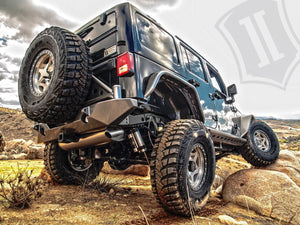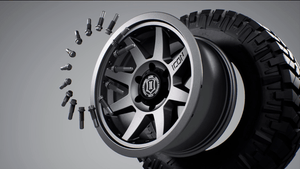
How It Works: Dropout vs. Carrier-Type Differentials
While every differential housing performs the same basic job—holding the gears that turn engine power into forward motion—there are two key designs you’ll find out there: dropout differentials and carrier differentials.
Dropout Differentials
Dropout differentials—also called third members—can be identified by their removable front center section. The ring-and-pinion gear set lives inside a carrier assembly that can be easily removed or “dropped out” for service or gear swaps. The legendary Ford 9-inch is the most famous example of a dropout differential, but GM, Toyota, Chrysler, and others have used them as well.

Common Dropout Designs
The Ford 9-inch has countless aftermarket configurations, but it’s not alone. Toyota’s lineup includes the 7.5”, 8”, 8” high-pinion, 8” clamshell, 8.5”, T100 IFS, and several 9”, 9.5”, and 10” variations. Mopar fans know dropout-style diffs as banjo-style differentials, with the Chrysler 8.75” being the standout example. Dana has also built many dropout-style units that show up across different makes and models.
Fun fact: in some circles, a front-loading dropout differential is called a pig-style diff, and across the pond, the ring gear is known as a crown wheel. No matter what you call it, they all get the job done.
Why Choose a Dropout Differential?
The main advantage of a dropout differential is ease of gear swaps. Because the entire gear case can be unbolted and removed, all the setup work—ring and pinion installation, backlash adjustment, and pattern checking—can be done comfortably on a workbench instead of under the vehicle. That means faster swaps, easier adjustments, and a cleaner install overall.
Carrier Differentials
Carrier differentials, on the other hand, are identified by their rear cover. To access the ring and pinion gears or other internals, you remove the cover on the back of the housing. GM’s well-known 10-bolt and 12-bolt designs fall into this category. In British terminology, these are called Salisbury differentials.

Strengths of Carrier Differentials
Carrier-style diffs are extremely common and have a few key strengths. Inspection and troubleshooting are easier—just pop the rear cover and you can see inside. No need to remove the entire center section to diagnose a problem. (Some aftermarket dropout diffs now include rear inspection covers to address this advantage.)
One drawback for off-roaders, however, is the exposed diff cover. On rocky trails, a stock stamped-steel cover can get peeled back or punctured by a rock or tree stump—leaving your gears vulnerable.
Protect Your Investment with Yukon Hardcore Diff Covers
 That’s where Yukon Hardcore Performance Diff Covers come in. Built from thick-walled nodular iron, these covers protect lockers, gears, and axles from impacts and housing flex. Each Yukon Hardcore cover features a durable powder coat finish, a magnetic drain plug, a premium gasket, and high-strength fasteners for a clean, reliable install that’s ready for anything the trail can throw at you.
That’s where Yukon Hardcore Performance Diff Covers come in. Built from thick-walled nodular iron, these covers protect lockers, gears, and axles from impacts and housing flex. Each Yukon Hardcore cover features a durable powder coat finish, a magnetic drain plug, a premium gasket, and high-strength fasteners for a clean, reliable install that’s ready for anything the trail can throw at you.
Know Your Setup
Understanding the difference between dropout and carrier differentials will help you make smarter choices when upgrading or servicing your drivetrain. Whether you’re re-gearing, installing a locker, or just protecting your investment, knowing how your diff works—and what upgrades it deserves—makes all the difference.
Share Article:
No comments yet. Be the first to add comment!
Leave a comment
Your email address will not be published. Required fields are marked with *







